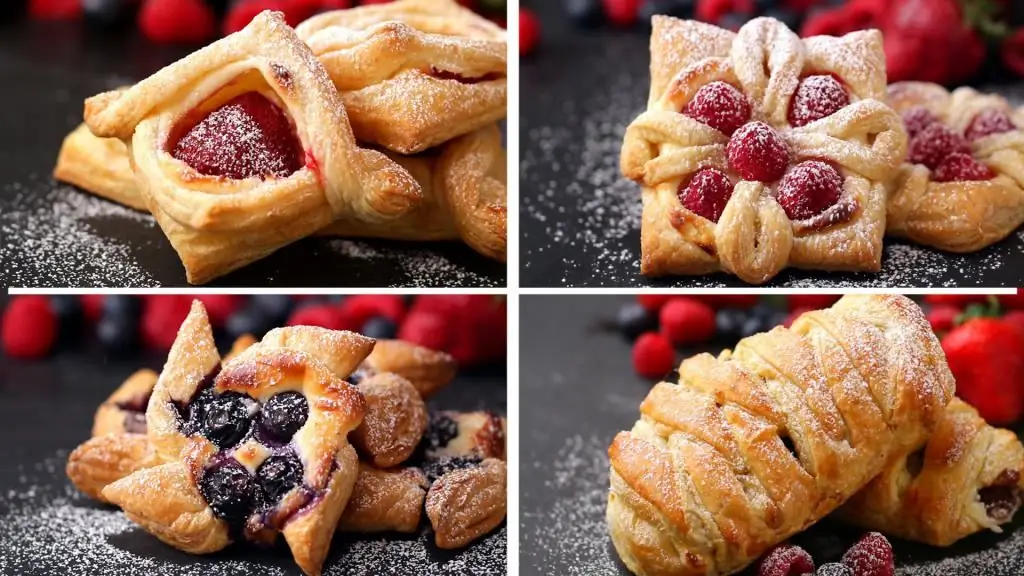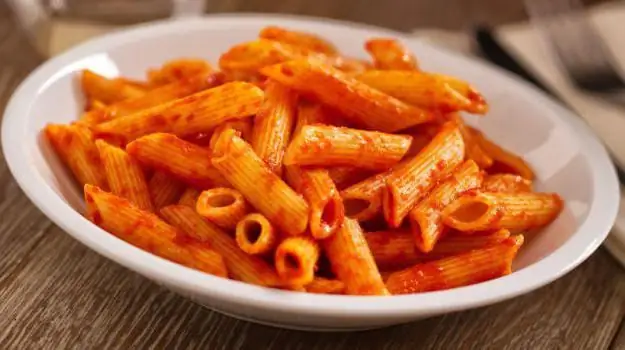2025 Author: Isabella Gilson | [email protected]. Last modified: 2025-01-23 12:50:38
Cellentani and manicotti, caserecce and pipe rigate, mafaldine and stelline, soba and udon, saifun and bifun, chuzma and nuasyr - for someone who treats pasta “calmly”, this is just a bunch of foreign words. For a true lover, this is a story about what varieties of pasta are in different countries.
Today, unlike in the past, a wide variety of types of pasta are presented on the shelves of shops and supermarkets. The photo below shows only a small number of different shapes, varieties and types of pasta.

Where and when did pasta appear?
The exact date when pasta appeared in the diet of people cannot be named by any culinary historian. Today, there are hypotheses about the primacy of the Etruscans, Chinese and Arabs in the invention of pasta.
Having carefully studied the bas-reliefs of the Etruscan necropolis, dating back to the 4th century BC. e., historians have come to the conclusion that they depict utensils, through which pasta was made.
According to another theory, the modern history of pasta begins in the 13th century, when Marco Polo returned to Venice from China. However, as early as the middle of the 12th century, most of the exports of Sicily were one type of pasta (pasta secca). That is, half a century before the return of the great traveler from China, the Italians were already making different types of pasta.
Other historians argue that the priority in the discovery of pasta, or rather such a type as noodles, belongs to China, where it was cooked before the advent of our era. Despite the fact that there is no exact information about when and where pasta appeared, people living in various countries and belonging to different cultures and nationalities enjoy eating them.
"National" features of pasta
In the cuisine of many peoples there are a variety of types of pasta and dishes in which they are used in one form or another.
For Europeans, the most favorite and familiar types are pasta made from wheat flour. They can be of various widths, lengths and shapes.
Most Asians, including the Chinese, prefer pasta made from rice flour. These are mainly pasta types such as rice noodles of various lengths and widths, translucent or white.

In Japan, Kazakhstan, Central Asia and some provinces of China, long noodles are very popular, which are drawn in a special way. In Asia, it is called "chuzma" and is used to make lagman.
In Japan, they are happy to cook a variety of pasta from a variety of flours. Soba noodles, made from a mixture of buckwheat and rice flour, are very popular and are used in the preparation of many dishes. From the starch of legumes, a special type of noodles is prepared - saifun.
In Arab countries, such types of pasta as reshta and nuasyr are popular.
For a long time, culinary specialists from all over the world have perfected the art of making pasta and created new recipes. Let's look at what pasta is like.
Russian pasta classification
Pasta can be classified according to various criteria and, above all, depending on the raw materials used in the manufacturing process. Pasta is mostly made from wheat flour, but can also be made from rice, rye and buckwheat flour, as well as cornstarch.
According to Russian standards, pasta made from wheat flour, depending on the varieties of wheat, are divided into the following groups: A, B, C. In addition, the type of flour is the basis for distinguishing three varieties of pasta - superior, first and second.
It is customary to refer to group A pasta made from flour of the highest, first and second grades of durum wheat. The raw material for group B pasta is flour of the highest and first grades from vitreous soft wheat. For group B pasta, baking flour of the highest and first grades is used.
In Russia, according to the established GOSTs,all pasta, depending on their shape, are divided into several types:
- curly;
- tubular;
- filamentous;
- ribbon.
In each of these types there are several types. Figured products can be made in a variety of shapes and sizes.
Tubular pasta includes directly pasta, feathers and horns. Depending on the diameter, they are divided into:
- "straws" - up to 4 mm in diameter;
- special - diameter from 4mm to 5.5mm;
- ordinary - diameter from 5.6 mm to 7 mm;
- amateur - more than 7 mm in diameter.
Filamentous pasta is subdivided into spider web vermicelli with a diameter of not more than 0.8 mm; thin - with a diameter of not more than 1.2 mm; ordinary - the diameter of which does not exceed 1.5 mm; amateur - up to 3 mm in diameter.
Ribbon-shaped pasta includes noodles, produced in various types and names. It can be with straight and wavy edges, corrugated and smooth. The thickness of the noodles cannot exceed 2 mm, and any width is allowed, but not less than 3 mm.
According to Russian GOSTs, all pasta is divided into two main groups: short, from 1.5 to 15 cm long, and long - from 15 to 50 cm. According to GOSTs, pasta is only long, noodles and vermicelli can be both long and short. Figured products, as well as horns and feathers are produced only in short.

Italian pasta classification
BItaly uses a slightly different classification of pasta than is customary in Russia. In total, there are about three hundred types of pasta in Italian cuisine, but hardly anyone will be able to name their exact number.
In Italy, all pasta is divided, first of all, into raw and dry. Dry pasta has a long shelf life and is sold in ordinary stores. Unlike them, raw pasta is immediately used to prepare a particular dish.
All Italian pasta is conditionally divided into the following subgroups:
- long;
- short;
- curly;
- small soup paste;
- intended for baking;
- filled (stuffed) pasta.
Long pasta
Long pasta includes tubes with a diameter of 1.2 to 2 mm, such as capellini, vermicelli, spaghetti and spaghettini and bucatini.
Flat ribbon pasta strips of noodles such as bavette, fettuccine, tagliatelle, linguine and pappardelle vary in width, ranging from 3mm to 13mm.
A separate type of long flat pasta is mafaldin with wavy edges.

Short pasta
There is a great variety of short pasta, the following types are the most popular.
Penne feathers are small tubes with a diameter of no more than 10 mm and a length of no more than 4 cm. The ends of such pasta are cut obliquely, which is why they resemble a sharpened feather. Their surface can be either smooth or corrugated.
Ditalini, which means "thimbles" in Italian. Small and very short tubes.
Rigatoni - short and long pasta tubes, wider than penne. Usually grooved.
Ziti - slightly arched tubules. Can be either short or long.
Horns (Elbow macaroni) - arched, small hollow tubes.
Curly pasta
Figured pasta in the Italian tradition can be very different both in shape and size. Let's name the most popular and frequently used forms of pasta.
Rotini - spirals, really small and short "springs".
Fuzzili - spirals, longer than rotini, and also twisted into a "spring". They can be of different types: long, thin, short and thick.
Kawatappi - very similar to fuzzili, but more stretched in length. They are hollow inside and corrugated outside.
Conchile - shells, and in literal translation from Italian - "shell of a clam". Differ in length and narrow internal cavity.
Lyumake - snails. Indeed, they look very similar to the snail's house from which it crawled out.
Farfalle - butterflies. We have adopted a less romantic and more prosaic name - "bows".

Radiatore - not very tasty and romantic sounding name - radiator, because of the grooves and grooves on each pasta.
Ruote is a wheel, our pasta of this shape is called “wheels”.
Orso - more like ricesmall pasta.
We will not consider the types of Italian curly pasta in more detail, we will simply list a few more names: torcio, gemelli, malloredas, cesaresia, cross di Galli, quadrefiore and gigli.
Small pasta for soups
The following types of small pasta are used to dress soups.
Anelli - small flat rings.
Alphabet - letter-shaped pasta.

Corals are miniature small tubes resembling coral in section.
Stellite - stars similar to our soup pasta of the same shape.
Filini - short strings.
Baking pasta
Cannelloni - look like a long and large diameter tube.
Manicotti are long pipes, like cannelloni, but with a smaller diameter.
Conchiglione - the largest, one might say, giant shells.
Conquillé are medium-sized shells.
Lumakoni are large snails.
Lasagna - flat and wide sheets, the edges of which can be either smooth or wavy.

Stuffed Pasta - Stuffed Pasta
Ravioli are square-shaped pasta dumplings very similar to regular Russian dumplings.
Tortellinni - small dumplings in the form of rings with a variety of fillings.
Gnocchi are small dumplings stuffed with mashed potatoes, cheese or spinach.
When asked what kind of pasta are, most of their fans inages 3 to 12 will answer that they are colored. Indeed, it is children who love such pasta the most! They are usually dyed with natural dyes. So, green pasta is obtained by adding spinach juice, purple - beetroot juice, black - squid ink.
In Italy they love black pasta and call it pasta nera. The size, shape and length of these pasta depend solely on the culinary imagination of the chef who decides to cook them.

We examined the most commonly used types and varieties of pasta, in fact, the range of pasta is much larger than we can imagine. Probably, the Italians themselves, with the exception of professional chefs, culinary historians and technologists of pasta production, do not know what pasta is so loved in their homeland.
Recommended:
Types of pastries, types of dough and recipes based on them

Baked goodies are always something tasty and fragrant, causing an increased appetite. The most important element in the preparation of any pastry is flour. No flour - no baking. Different fats (vegetable oil, butter, margarine) are already added to a certain type and type of flour. Also a frequent ingredient in the manufacture of pastries are: eggs and yeast
Useful fast food: types, types, recipes

Fast food shops are very helpful. Of course, such food is very difficult to call he althy. Here in the assortment are walking dogs, hamburgers, french fries. Someone swallows another portion without hesitation, but most people are well aware of how such nutrition affects he alth in general and the figure in particular. But does fast food always mean bad food? Is there a he althy fast food?
Types of test. Types of yeast and puff pastry

What a variety of dishes, in which the main ingredient is flour! Consider what types of tests are and what are their main features. We will tell you more about yeast and puff pastries
Pasta is pasta or sauce? Why is pasta a pasta?

What is pasta: pasta, sauce or both? We will try to answer this question in this article. We will tell you about the origin of pasta and their triumphant march around the world after the discovery of America and the invention of the spaghetti machine
He althy fast food: types, types, benefits for the body

Steamed lean steak, juicy fresh vegetables and a rye bread bun are a he althy snack. But one has only to fry the meat in a pan with vegetable oil, add mayonnaise and spices, replace the bun with an ordinary white bun with sesame seeds, and a he althy set of products will turn into a typical burger, which simply by definition cannot be he althy. So does he althy fast food exist?

